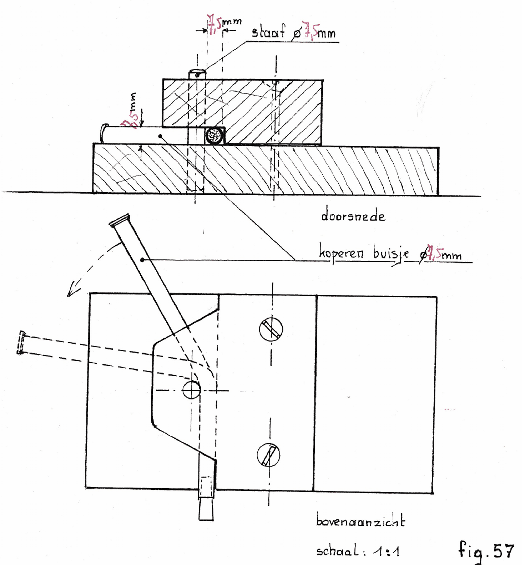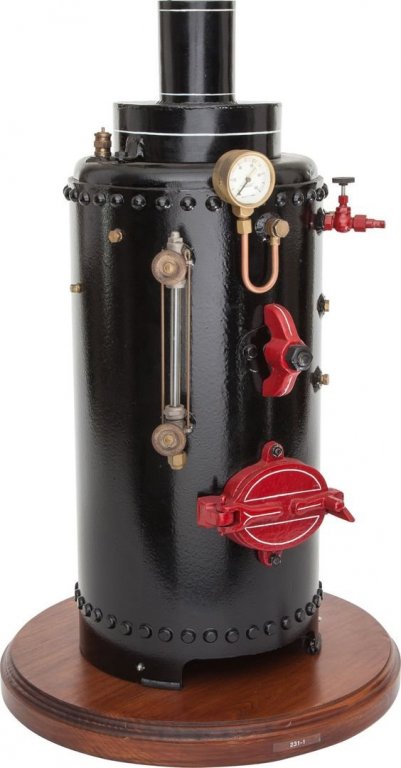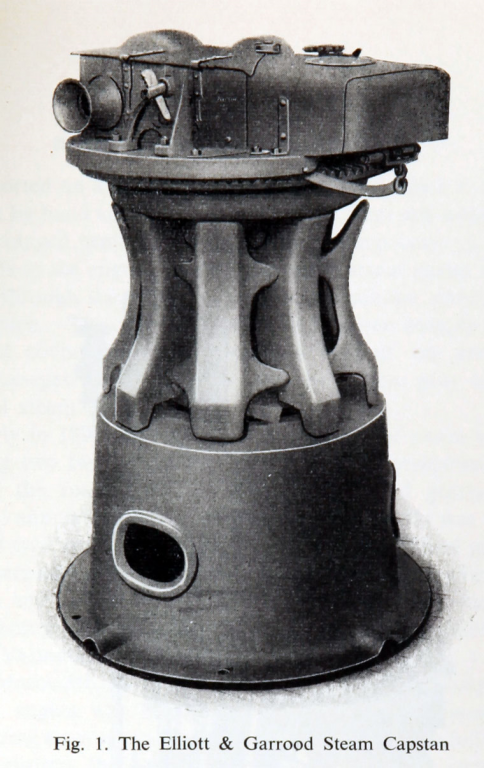-
Posts
1,553 -
Joined
-
Last visited
Content Type
Profiles
Forums
Gallery
Events
Posts posted by G.L.
-
-
-
On 1/12/2019 at 6:21 PM, cog said:
inventive, I really like it
Thanks Carl, Pat, Michael and Yves.
Here is the progress of last week:
Part 15: The forward compartments.
The area in front of the equipment store (circled part of the plan) consists of a spare nets repository (starboard) and a small warp hauling line store (portside), separated from each other by a central passageway in which is the anchor chain pipe. Those compartments are cut through in my cross section (dotted line on the plan).
I start with making the anchor chain pipe. The pipe has a 90° turn to lead trough the bulwark to the chain box. A design of a folding bench is given in the practicum. The pipe has to be filled with fine sand to prevent it from nodding. The pipe must be heated and folded.

However my problem is that the practicum is explaining to make a cross section on scale 1/30 and I are making mine on scale 1/20. My pipe has a diameter of 7.5 mm and not the 5 mm for the 1/30 scale. Whatever I try and however careful I am, my pipe is cracking instead of bending.
I consult a modeler colleague who advises me to fill the pipe with melted lead instead of sand.
So I heat the pipe to make the brass soft, melt some lead in improvised melting pot of a tin can and fill the pipe.I make now a new attempt to bend the pipe.
I have now a 90° curve in my pipe. It is far from perfect and the curve is a bit wider than I would like, but I will do with it.
I will melt the lead out of it and finish the pipe.The pipe, painted and provided with two mounting brackets and the anchor chain.
Attaching the pipe into position.
Preparing to lay the lower deck.
The deck is laid.
Placing the profile slats for the bulwarks.
Placing the bulwark of the spare net store.
Placing the bulwark of the small warp hauling line store.
The forward compartments.
-
That is what I call craftsmanship.
- mtaylor and Keith Black
-
 2
2
-
Original building board! It looks to me very stable to sand the frames.
- mtaylor, aviaamator, druxey and 2 others
-
 5
5
-
-
On 1/13/2019 at 9:41 PM, Valeriy V said:
I will try to answer questions as far as the translator and a small stock of my knowledge will allow me.
1) Recipe for cooking 1 l. electrolyte for electroforming:
- we part 200 g of copper vitriol in 500 ml of water
- we filter the resulting solution
- add 134 ml. automotive electrolyte density of 1.28
- bring distilled water to 1 l. and mix well2) Deposition Current:
15 mA * S (part coverage area)3) To calculate the time of deposition of copper on small areas:
t = (840 * m) / I
time - in hours, mass - in grams, current - in milliamperes4) Copper precipitated mass:
m = (S * h) * ρ
m - mass of copper in grams
S - area in cm2
h - thickness in cm
ρ = 8.93 g / cm3 - the proportion of copper5) Any pure copper is used as an anode.
Valeriy,
Thank you very much for the explanation but it remains still a bit of alchemy for me. I will have to deepen your pictures and recipe above with some colleagues modeling friends who have more knowledge about metallurgy than me.
- popeye the sailor, Canute and mtaylor
-
 3
3
-
What a beautiful ship!
At scale 1/36 it will be a large model, I like that.
I am subscribing to your log.
- mtaylor and aviaamator
-
 2
2
-
Smacks were often equipped with a steam capstan. In the 19th century the capstan was driven by a donkey steam engine which was connected to a gearbox below the capstan with a connecting rod. Later a more effective capstan was developed: the Elliott & Garrod's steam capstan. The steam under pressure could be led immediately from the steam pressure boiler to a gearbox on top of the capstan. This effected less loss of power than with connecting rods. The steam pressure boiler is situated outside the cross section, so I don't have to make it.
On the other hand, the capstan has to be made, but that is a job for later. On the picture a Elliot & Garrod's steam capstan of a later generation than that on my smack.
I start with lying the carlings on which will stand the capstan.
I drill a hole in the middle carling. Through that hole will lead the steam pipe to the capstan.
I curve a 4 mm brass tube which will lead from the upper deck to the lower deck.
Below the lower deck the steam pipe goes further horizontally to the engine room more aft. My steam pipe will be cut off at the edge of the cross section. I want to end the pipe with a flange.
Making the flange: drawing the outline on a piece of brass.
Making a hole in it
Making the boltholes
Sawing it out
Filing of the outline
Soldering the flange on the pipe.
Making a mounting bracket.
The steam pipe is leading along quite a long distance, including more than two meters through the ice cooled fish hold. I can imagine that there will be a significant loss of temperature of the steam. There is nothing told in the practicum about insulation of the steam pipe. During the twenties of last century the health risks of using asbestos were not yet known, so I suppose that the pipe was insulated with a layer of asbestos. I will do it as well on my model. I will of course not use real asbestos but I will try to make a look alike. To do so, I take a roll of gauze bandage.
I cut some narrow bars of it.
I wind them around the tube and moisten them with textile glue.
Then I paint them with white acrylic paint.
The pipes into their places. The pipe below deck still needs a support for a while until the glue is dry.
-
-
On 1/6/2019 at 2:16 PM, Adrift said:
I am new to this hobby and the forums. It is threads like this that inspire and motivate myself and im sure many others.
This is just amazing. The history lesson at the start and throughout. the detail being put in makes this just a phenominal work of art.
I hope to one day be able to have the knowledge to achieve such a level of craftmanship.
I look forward to what lies ahead. Thank You sir G.L. for this lovely build that i am thrilled to follow
all the best
Berto
Berto,
Welcome on board of this log. The Modelshipwold forum is the place to be when you are interested in maritime history.
Don't praise my craftmanship too much, you will see in other members logs that on this forum real artists are at work.
I wish you much pleasure in following the build of my cross section.
-
Tony,
Your planking looks to me very good. This will become an excellent model.
- mtaylor, tkay11 and Andrea Rossato
-
 3
3
-
1 hour ago, Valeriy V said:
Details along the arrow are also made by electroforming.
I am looking very much forward to the progress of the Varyag to see how electroforming is working.
-
7 hours ago, DORIS said:
Oh, I have almost forgotten - here is one of my helpers - sometimes is very tired and sleepy.I can't understand why?😄
I do not either because the bottle is still full.
- Piet, mtaylor, popeye the sailor and 4 others
-
 7
7
-
The deck beams which meet frames are reinforced with iron knees. I make them out of strips of brass (I apologize for the blurry images).
Nail holes in the knees.
After they are blackened, I nail them on the deck beam.
Marking and drilling the nail holes in the hull. I will not fasten the deck beam immediately to the model before I made some progress to the fish hold.
The fish hold could be divided in small cubus-shaped compartments by mean of removable planks to stow away the fish with ice. In the fish hold stood wooden vertical pillars with slots in it to hold the planks. I will only place some planks to make clear how it was like.
From the late 19th century on, fishermen who went for a couple of days to sea stored their catch between layers of ice. In those days winter ice was shipped from Norway to our fishery ports. After the first World War fishermen took factory made ice with them. On certain vessels they used some of the fish compartments to store ice. On other boats there was a special insulated ice container on board.
For this cross section Mr. Verleene relies to the construction of a Flemish (Belgian) fishing vessel. The icebox was made of a slat construction with cork plates in between and that all was covered with galvanized or zinc plates. The box could contain approx. 1200 kg ice.
I start by making the container sides. They are made off horizontal paneling. To give it all a bit of initial strength I glue a piece of waste paper on the inside of the walls. It will soon be covered by the inner lining of the icebox.I don't have to imitate the cork insulation material, I use real cork, namely a wine cork. I saw the cork in slices.
I glue a cork layer on the edge of the icebox wall.
The galvanized plates are made of tin-plate.
The plates were nailed on the slat construction. I imitate the nails by punching them in the plate.
The tin is a bit too glossy, therefore I rub it in with tiffany patina to give it a zinc look.
Gluing the plates.
The ice compartment is entirely plated. The plate right below is corroded due to a bit too long contact with the tiffany patina. I will sand it slightly.
-
-
22 hours ago, DORIS said:
If you wish to be there, you can send me your photo through PM and I will try to imitate your face in one of the sailors. During next months I will start to make first crew members.
I will be pleased to have my friends from MSW on board.
Best regards
Doris,
I would be very honored to be a crewmember of your HMS Royal Katherine. I will send you a picture.
- popeye the sailor, DORIS, EJ_L and 2 others
-
 5
5
-
9 hours ago, DORIS said:
Luponero: Thank you for your comment, I'm glad you like my work.
No problem, druxey. If you wish, you can belong to my crew on the Royal Katherine and also visit this great cabin. There will be plenty of seamen on the model and I am going to create them according to real people I know.
I cannot guarantee the perfect portrait of the face, but I will definitely try to imitate.😉
Best regards,
Doris
Doris,
I am looking very much forward to see you making the crew. What a challenge to make portraits of real existing people!
Congratulations on stylish interior of the cabin.
- BETAQDAVE, EJ_L, Mirabell61 and 3 others
-
 6
6
-
-
Alexander,
Did you make your carvings with a chisel, a knife or a rotary tool?
Your boeier yacht becomes a real beauty.
- mtaylor, Keith Black and BETAQDAVE
-
 3
3
-
Part 14: The after bulkhead
Some carlings have to be placed on the deck beams, therefore I have to make some notches in the beams. I make them using wood chisels.
All the notches are made. The beams are just laying on the model without glue.
Before starting to build the bulkhead that separates the equipment store from the fish hold, I stain the deck beams and place the one which will support the bulkhead definitively.
Left of the middle of the bulkhead is a passageway. I place a provisory shelf with the same dimensions as the passageway.
Building the bulkhead to the left and to the right of the passageway.
Below the hatch of the equipment store there are two steps on the bulwark to descend in the store. I forgot to make pictures of the making of them.
Because I find difficult to use the steps without a handrail I will place handrails although it is not described in the practicum.
I mill some 3 cm long slots in a piece of 3 mm thick oak.I saw the plank in the middle, and then to the right width.
I saw the shape of the handrails,
and round off the angled sides with sandpaper.
Gluing the handrails.
Like this it is much easier for my crew to use the steps.
- cog, michael mott, yvesvidal and 9 others
-
 12
12
-
Thanks Carl and Patrick and all those who pushed the 'like button'.
Here is the progress of last week:
When I showed the progress on my cross section to my modelers friends, one of them asked me if there would be gratings in the rope- and fender stores. I said him that it was not provided in the practicum. Afterwards I thought about it and I realized that it would make sense if the ropes and rope fenders were laying on gratings to protect them against mold. And also very important: a grating would hide the mess I made of my deck.
I saw 3mm strips out of a 3mm thick mahogany plank.
I glue them together as one surface with a droplet of glue at each side.
In the whole of strips, I saw at 3mm intervals 1.5mm deep and 3 mm wide slits
I disassemble the strip again, using a cutter knife.
I start gluing 3mm x 1.5mm strips in the slits.
The grating, ready to be sawn in different parts and to be sanded.
I suppose that the grating could be brought outside therefore I make the grating for the trawl warp storage in three parts which can pass each through the hatch.
One part in place
Two parts in place.
All three parts in place.
The grating of the rope fender storage, partly cut away.
-
-
-






Golden Hind (ex-Pelican) by Baker - FINISHED - scale 1/45 - Galleon late 16th century
in - Build logs for subjects built 1501 - 1750
Posted
Thanks Patrick